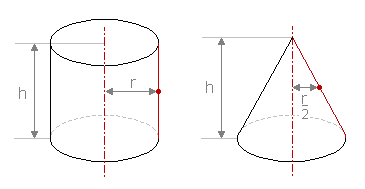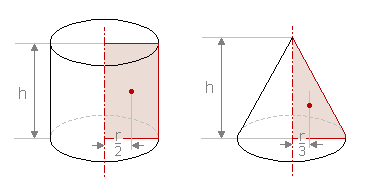| The Compendium Geometry is an eBook providing facts, formulas and explanations about geometry. |

|

Home  Analytic Geometry Analytic Geometry  3D Solids 3D Solids  General Rules for 3D Solids General Rules for 3D Solids |
|






|
|
General Rules for 3D Solids
Theorem of CavalieriIf two solids have equal altitude, and all sections made by planes parallel to their respective bases are always equal at the same relative altitude, then the volumes of the two solids are equal.
Simpson's RuleSimpson's Rule calculates a (coarse) approximation of irregular solids. If the areas of the base surface, of the top surface and of the cross section at half the height of the solid are AB, AT, and Am, respectively, then the volume V of this solid can be calculated using the following approximation:
Pappus's Centroid RulesSurface of revolution: the surface area S of a surface of revolution is equal to the product of the arc length l of the generating curve and the distance d traveled by the curve's geometric centroid. The surface of revolution is created by the revolution of a curve about an arbitrary axis. This rule is also known as the first theorem of Pappus, or Guldin's first rule.
Volume of a solid of revolution: the volume V of a solid of revolution is equal to the product of the area of the rotated shape and the distance traveled by the shape's geometric centroid. The volume of revolution is created by the revolution of an arbitrary shape about an external axis. This rule is also known as the second theorem of Pappus, or Guldin's second rule.
|
|
Home  Analytic Geometry Analytic Geometry  3D Solids 3D Solids  General Rules for 3D Solids General Rules for 3D Solids |
|
Last Update: 2010-12-06




